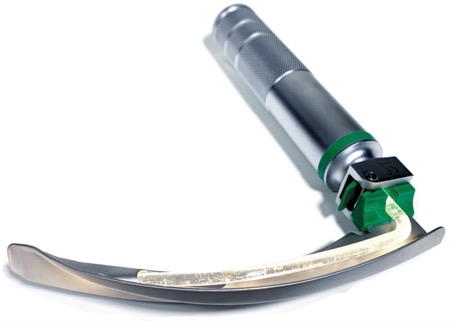
The reusable laryngoscope has been identified as the second most highly biocontaminated surface in the OR.1 Occult blood and pathogens, some with antibiotic resistance, have been found routinely on laryngoscopes considered ready for use. This reality, along with heavy biocontamination within the anesthesia work environment (AWE), is a constant unseen threat for cross-contamination via laryngoscopes, gloved hands and all anesthesia-related airway instrumentation procedures. Ignaz Semmelweis, the 19th-century champion of antisepsis, found that heightened awareness alone could not overcome status quo bias. Can we?
Even with separable components, a laryngoscope is a single instrument. Due to differing interests, however, some observers continue to contend it has two conflicting Spaulding classifications: a semi-critical blade and a non-critical handle. Since 2013, we have applied high-level disinfection or sterilization to reusable blades, while cautiously neglecting reusable handle status. Sterile technique establishes that when an unsterile hand or handle touches a sterile blade, the blade becomes unsterile.2 Sterility is unconditional. “Maybe” sterile is not an option and there are no varying degrees of sterility. Nonetheless, this same principle cannot be applied to non-sterility given that unsterile places are not equally contaminated.
During my residency, the direct laryngoscope was already obsolete. Between anesthetic interventions, we washed the detachable laryngoscope blades by hand. The handles might get wiped free of visible dregs and residue. Wearing gloves protected us from the contaminated laryngoscope more than we protected the patient from it—that is, if we wore gloves. Inevitably, with an element of surprise, the sophomoric “test” of putting the cleaned blade into our own mouth, as requested by the attending staff, was obligatory. “Maybe” was not an option because the blade either is clean enough for your own mouth or it isn’t. After a brief moment of introspection, we’d promptly start the next anesthetic reusing the same laryngoscope while Semmelweis rolled over in his grave. Are we surprised that decades later, after routine low-level disinfection with antibacterial wipes, up to 100% of users insisted they would not put such a laryngoscope into their own mouths?3
Any cursory literature review identifies the laryngoscope as a source of cross-contamination resulting in hospital-acquired infection (HAI) and deaths going back to the 1990s.4-7 Past studies using cultures, and more recently employed adenosine triphosphate luminescence and enzyme staining, have overwhelmingly confirmed the ineffectiveness of routine low-level disinfection practices with bactericidal wipes, and that “cleaned” and “ready to use” laryngoscope handles have blood and pathogenic biocontamination levels second only to the floor of the OR, with levels “comparable to … hospital toilet seats.”1,7 Moreover, we now have a link between the AWE biocontamination level and 30-day postoperative infections.8 Yet somehow, we still have no clear consensus on how best to process the primary instrument within our workspace.7,9
HAIs are a substantial drain on healthcare budgets, costing an estimated $45 billion annually. Unfortunately, they remained well hidden within medical practice for decades.10 It’s fair to say we don’t know what proportion of HAIs is laryngoscope related, but a randomized controlled trial likely will never be done largely because it is unnecessary. Cross-contamination of blood and pathogens between patients is unacceptable during airway instrumentation procedures, and we should all strive to eliminate it. Indeed, many concerned professional organizations—including the ASA, the American Academy of Anesthesiologist Assistants, the Association of Perioperative Registered Nurses and the American Association of Nurse Anesthetists—endorse the Society of Healthcare Epidemiology of America’s recommendations in its 2018 Infection Control in Anesthesiology Guidelines, essentially classifying the laryngoscope (blade and handle) a Spaulding semi-critical device requiring high-level disinfection or sterilization between uses.11,12 These endorsements, unfortunately, appear to be only window dressing for an underlying status quo bias.
We have made progress implementing laryngoscope blade sterility, but we’ve ignored contamination of the reusable handle. Resisting empirical evidence is quickly becoming untenable in spite of an accomplice that is the CDC, as it continues to deftly defer Spaulding class designation of the reusable handle to facilities by allowing carefree choice of multiple instructions for use provided by the manufacturers. “Risk stratification should be the responsibility of epidemiologists and infection control experts, who develop professional guidelines,” and not deferred to facility operators struggling to maintain exceptional patient care standards with never-ending cuts in reimbursement.13 This tension between patient safety and the cost of reprocessing reusable scopes has pushed many facilities to use single-use disposable (SUD) laryngoscopes exclusively, but “the idea that single-use devices safeguard against infection better than reusable, decontaminated devices has proven to be a myth“ and “if reusable equipment is used with minimal administrative costs, excellent but inexpensive care can be delivered … while leaving a low carbon footprint.”14,15
Nevertheless, the cost–effectiveness debate between SUD laryngoscopes and reprocessing reusable scopes continues.16 Sterilizing reusable laryngoscope blades and handles reduces their life span, is costly, is labor-intensive, and creates unreliability with related added risks. In addition, due to unavoidable reassembly and testing, closing the loop with sterile storage until the next point of use is almost impossible. There is no debate, however, regarding the burden of infectious medical waste from healthcare facilities—particularly the ORs—including an estimated 3 million pounds of battery-packed SUD laryngoscopes each year in the United States alone. Today, just the resources necessary for disposal of SUD scopes as trash costs ORs approximately $1 million to $2 million per year. Fortunately, new ideas regarding “total product life cycle” and “life cycle costing” are beginning to reprioritize the motives driving our laryngoscope choices.17,18 This is a great start, but there is much more we can do.
It’s time we take the next steps toward cleaning up the “head of the bed” and provide a sterile medical instrument for every intubation. Everyone deserves a sterile instrument to be used for an invasive medical procedure and the laryngoscope should be no exception. The laryngoscope has one critical duty: aiding visualization of the larynx for less than a minute. It is a simple lighted retractor, and we need to begin treating it that way if we are to make any progress in reducing HAI risks for patients. The current reusable laryngoscope design requires a dramatic shift toward simplification for sterilization. Futility is painstakingly attempting to disinfect the AWE as we meticulously wipe around the highly contaminated laryngoscope.19 Is there a difference between reusing laryngoscope handles and reusing syringes between patients after simply changing the needles? Every professional medical organization, including the ASA, denounces this practice at every level because of the proven danger of spreading infectious disease.20 A sterile laryngoscope for every intubation ought to be an identical objective. We have come a long way from the time when physicians spat tobacco on the floor, but it is going to take more foresight, discovery, collaboration and critical thinking to have the impact we should expect from ourselves as professionals to improve the current state of the entire unsanitary AWE, starting with the laryngoscope.
References
- Ramirez A, Mohan S, Miller R. Surface contamination in the operating room: use of adenosine triphosphate monitoring. J Anesth. 2018;33:85-89.
- RNPedia.com. Principles of Sterility. Published 2023. Accessed July 14, 2024. bit.ly/466XONU
- Telang R, Patil V, Ranganathan P, et al. Decontamination of laryngoscope blades: is our practice adequate? J Postgrad Med. 2010;56:257-261.
- Foweraker JE. The laryngoscope as a potential source of cross-infection. J Hosp Infect. 1995;29:315-316.
- Jones BL, Gorman LJ, Simpson J. An outbreak of Serratia marcescens in two neonatal intensive care units. J Hosp Infect. 2000;46(4):314-319.
- Ayatollahi A, Amini A, Rahimi S. Prevalence of gram-negative bacilli isolated from the equipment and surfaces in hospital wards of Golestan Province, North of Iran. Europ J Microbiol Immunol. 2017;7(4):261-266.
- De Sousa N, Levy CE, Freitas M. Laryngoscope blades and handles as sources of cross-infection: an integrative review. J Hosp Infect. 2013;83(4):269-275.
- Loftus R, Brown J, Patel H. Transmission dynamics of gram-negative pathogens in the anesthesia work area. Anesth Analg. 2015;120(4):819-826.
- Chaskar V, Dave N, Dais R. Disinfection of laryngoscopes: a survey of practice. Indian J Anesth. 2017;61(3):245-249.
- Stone PW. Economic burden of healthcare-associated infections: an American perspective. Expert Rev Pharmacoecon Outcomes Res. 2009;9(5):417-422.
- Wicklin S. Contamination and disinfection of rigid laryngoscopes: a literature review 2019. AORN J. 2019;110(1):A3-A13,2-117,P1-P20,120-124.
- American Society of Anesthesiologists. New guidance outlines recommendations for infection control in anesthesiology. Published December 11, 2018. Accessed July 14, 2024. bit.ly/4d4D7EF
- Sherman JD, Hopf HW. Balancing infection control and environmental protection as a matter of patient safety: the case of laryngoscope handles. Anesth Analg. 2018;127(2):576-579.
- Sundararaman L. Health care wastage: an affliction on our nation’s health and our planet! Resour Conserv Recycl. 2019;155:104643.
- Sundararaman L. Health care wastage: an affliction on our nation’s health and our planet! J Cataract Refract Surg. 2017;43:1391-1398.
- Sherman J. Reusable vs. disposable laryngoscopes. APSF Newsletter. 2019;33(3):91.
- FDA. Total product life cycle for medical devices. 2023. Accessed July 14, 2024. bit.ly/4bHNA7Q
- Sherman J, Raibley L, Eckelman M. Life cycle assessment and costing methods for device procurement: comparing reusable and single-use disposable laryngoscopes. Anesth Analg. 2018;127(2):434-443.
- Charnin JE, Loftus RW, APSF Patient Safety Advisory Group – Infectious Diseases. ASA Monitor. 2023;87:36-37.
- American Society of Anesthesiologists. Statement on recommendations for safe injection practices, Committee on Occupational Health. ASA Standards and Practice Parameters. Published October 2022. Accessed July 14, 2024. bit.ly/3zJduuH
This article is from the September 2024 print issue.


